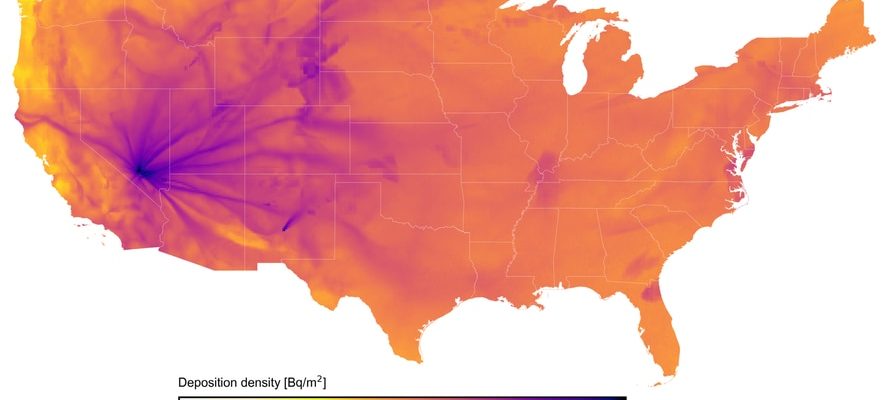On July 16, 1945, a mushroom cloud rose in the sky of the New Mexico desert (United States). The location, an arid, sandy stretch of desert, was chosen by the Manhattan Project team – scientists and American military personnel led by physicist Robert Oppenheimer – to detonate “Gadget”, the first atomic bomb in history. The essay, named “Trinity”, is also the pinnacle ofOppenheimerthe film by Christopher Nolan in theaters since July 19 and which traces the life of the scientist.
How many Americans were then affected by the ashes and radioactive particles carried by the explosion? The extent of the radioactive cloud propagated during this historic test had never been precisely measured. Until the publication, Thursday July 20, of a study carried out by a research team from the Science & Global Security Laboratory, Princeton Universitywhere Robert Oppenheimer lived and taught.
Published on Arxiv, a scientific pre-publication site, this work has not yet been peer reviewed or published in an official journal. If they could therefore be amended, they reveal however that the cloud and its fallout caused by the explosion of the first atomic bomb traveled over 46 American states, to cross the borders of Canada and Mexico. A far greater impact than the estimates of Manhattan Project officials and the few surveys available so far – which were limited to New Mexico and only 24 hours after the explosion – suggested.
To reach these conclusions, the Princeton research team, led by French physicist Sébastien Philippe, used modeling software, but also new historical meteorological data, which did not exist in 1945. This work allowed them to reconstruct, hour by hour, the air circulation when Oppenheimer and his teams pressed the detonator. They were thus able to follow the radioactive cloud during the first 10 days of its journey through the atmosphere.
The debate on the health consequences revived?
Submitted to a major scientific journal, the study highlights “significant radioactive deposits” in New Mexico where, due to weather conditions, the cloud caused by “Gadget” returned after its broadcast. The work also reports significant deposits in Nevada, Utah, Wyoming, Colorado, Arizona, and Idaho, as well as dozens of federally recognized tribal Indian lands in the United States. “The Trinity explosion was particularly polluting, due to the power of the bomb, relatively strong compared to subsequent tests, and especially because of its position, on a very low tower, which generates more fallout”, underlines Sébastien Philippe, interviewed by L’Express.
This work, which also traces the effects of 93 other American nuclear tests subsequently carried out in the State of New Mexico, could contribute to fueling the debate around the health impacts of these nuclear explosions, and in particular the first of them. “Our study shows that the effects of Trinity on health could go well beyond what has already been shown during a campaign of scientific studies carried out at the end of the 1990s”, abounds Sébastien Philippe.
Map describing the deposits of radioactive materials throughout the United States following the Trinity test in New Mexico and 93 atmospheric tests carried out subsequently in the State of Nevada.
© / Sebastien Philippe, Susan Alzner, Gilbert P. Compo, Mason Grimshaw, Megan Smith
About 500,000 people lived within a 250 kilometer radius of the site, according to US vital records. Some families even lived only twenty kilometers away, according to one of Trinity’s main victims’ associations, Tularosa Basin Downwinders Consortium. And yet, no civilians were scheduled for the test, and none were evacuated. The health consequences could have been considerable, even if they are still poorly evaluated, due to a lack of precise data up to now. Nevertheless, infant mortality recorded in 1945 – the year of the test – was 38% higher than in 1946 and 57% higher than in 1947, according to the New Mexico State Department of Health. The mapping established by the Science & Global Security laboratory team does not directly establish the health risk incurred. “But our results can be used to refine the level of contamination of Americans and agricultural products affected by radioactive clouds”, specifies Sébastien Philippe.
Since the release ofOppenheimer, more and more voices are being heard to review the conditions for compensating victims of nuclear tests in the United States. “78 years after the trial on which this film is centered, New Mexico continues to deal with collateral damage from Trinity,” New Mexico Senator Ben Ray Luján said when the film was released. THE Radiation Exposure Compensation Actthe legislation voted in the 1990s and still in force, only takes into account the tests carried out from the 1950s. Thus, with a few rare exceptions, no victim of the radioactive fallout from Trinity has been compensated, despite several legislative proposals in recent years, in particular brought by the senator from New Mexico.
